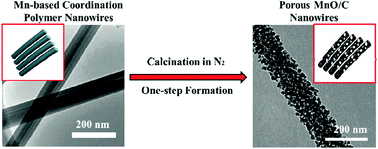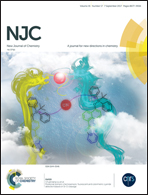Facile synthesis of porous manganese oxide/carbon composite nanowires for energy storage†
Abstract
One-dimensional porous nanostructures have attracted significant attention for their application in lithium-ion batteries because of their many advantages including high accessibility to the electrolyte, short transport path of Li+, rapid axial transport of electrons, and superior volume expansion buffer. Herein, we synthesized subtly porous MnO/C composite nanowires via a one-step decomposition and carbonization process of a manganese-based coordination polymer precursor, which was obtained via a hydrothermal approach. MnO nanocrystals are demonstrated to be strongly anchored and uniformly distributed in the porous carbon matrix using scanning electron microscopy (SEM), transmission electron microscopy (TEM), and line-scan elemental analysis. The porous carbon matrix not only improves the electronic connectivity among MnO nanocrystals, but also efficiently buffers the volume expansion during the lithiation/delithiation process. The as-prepared MnO/C composite nanowires exhibit capacity as high as 978.4 mA h g−1 at a current density of 0.5 A g−1 and reasonable cyclic performance and rate capability. The reversible capacity is 832 mA h g−1 after cycling 100 times at 0.5 A g−1 and the rate capability is 782 mA h g−1 at a current density of 2 A g−1.



 Please wait while we load your content...
Please wait while we load your content...